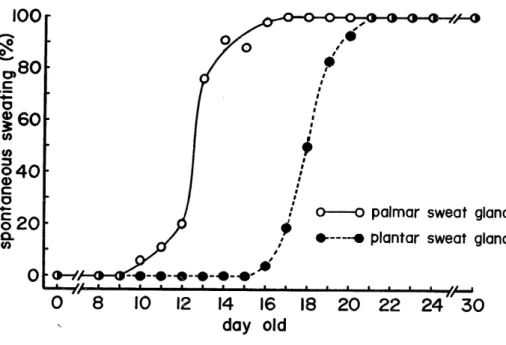Acta Med. Nagasaki 26: 1-3
Appearance of the Spontaneous Secretion of the Palmar and Plantar Sweat Glands in Rats during Postnatal Period
Itsuro MATSUMOTO and Kiichiro ABE
Department of Physiology, Nagasaki University School of Medicine,
Nagasaki 852, Japan
Received for publication, March 30, 1981
Functional development of the palmar and plantar sweat glands in rats during post- natal period was evaluated by examining the appearance of spontaneous secretion of these sweat glands. After non-secretory period, spontaneous secretion of the palmar sweat glands began to occur between 10 and 17 days and that of the plantar sweat glands between 16 and 21 days after birth. In each individual rat, the palmar sweat glands began to secrete spontaneously 5 ± 1.5 days (mean ± SEM) earlier than did the plantar glands.
INTRODUCTION
In rats the sweat glands are found only in the plantar and palmar surfaces (RING
& RANDALL, 1947). Observations of the spontaneous secretion of these sweat glands have been done by NAKAGAWA (1950), FUJISAKI (1954), NINAGAWA (1956), BLOZOVSKI & SIVADJIAN (1959) and HAYASHI & NAKAGAWA (1963). It was reported by HAYASHI & NAKAGAWA (1963) that the spontaneous secretion of the plantar sweat glands in rats began to occur between the 17th and 30th postnatal days. SIVADJIAN &
TREFOUEL (1975) reported that the palmar sweat glands in the rat began to secrete at the 9th days after birth and the plantar did at 14th days. In rats the palmar sweat glands became responsive to 10-5 M mecholyl a few days earlier than the plantar glands (MATSUMOTO & ABE, 1976). In the present study the appearance of the spontaneous secretion of the palmar sweat glands in rats during postnatal period was examined in comparison with that of the plantar sweat glands.
MATERIALS AND METHODS
Forty newborn albino rats of either sex of the Wistar strain were used in the present
松 本 逸 郎,安 倍 紀 一 郎
